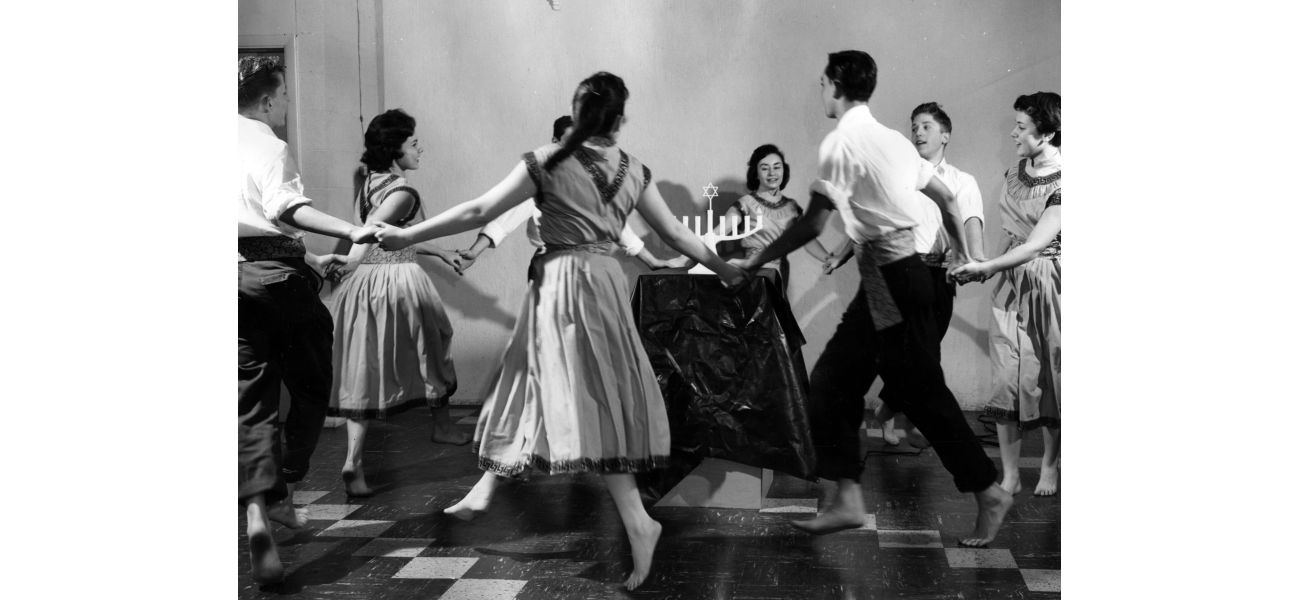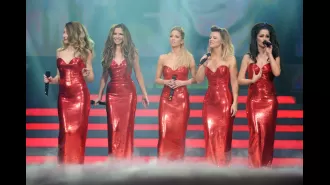Ron Grossman reminisces about his childhood Hanukkah celebrations in the neighborhood of Albany Park.
A Chicago native recalls his childhood experiences celebrating Hanukkah.
December 22nd 2024.

Starting in the new year, Ron Grossman will be sharing his thoughts on Chicago through occasional columns in the Sunday Life+Travel section. You may already be familiar with his regular history features, but now he will also be delving into the city's present and future. Here's a sneak peek of what's to come.
Growing up, I remember a time when 4341 N. Sacramento Ave. was the only Jewish building on our block. This wasn't unusual or malicious, it was just how neighborhoods in Chicago were in the 1950s. Each area had its own ethnic population, and in Albany Park, the Jewish and non-Jewish sections met at this intersection. This happened to be right next to the courtyard building where my family lived on the second floor. Looking out of our windows in late December, I couldn't help but feel a sense of difference between my family's religion and that of some of my classmates at Bateman Elementary School.
I would often ask my mom, "Why can't we have a Christmas tree like Ralph Lippert's family?" It seemed like everyone else had one. They probably bought it from a vendor at the gas station on Montrose Avenue, just down the block from us. But my mom would always remind me that we have Hanukkah to celebrate. And she had a point. Hanukkah falls around the same time as Christmas and has its own rich traditions that have been adapted to fit the American culture.
In Europe, where anti-Semitism was rampant, Jews were not allowed to celebrate Christmas or participate in any of its festivities. But in America, a country built on diversity, the holiday was more inclusive. Santa Claus and his jolly spirit were emphasized, and even Jewish children were encouraged to visit him at department stores to share their holiday wishes. My friend Tommy Lampert would excitedly show me the presents under his Christmas tree, but my mom would remind me that we have eight days of Hanukkah to open gifts. It was a reminder of the duration and significance of our own holiday.
I learned more about the history and meaning of Hanukkah from my Hebrew school teacher, who taught in a storefront synagogue on Kedzie Avenue. It was a former laundry, and later became a church with a West African congregation. Despite not reading from the Bible, my teacher's storytelling skills had me captivated. It was like watching a thrilling cowboy-and-Indian movie, chapter by chapter, on a Saturday afternoon at the local theater.
The story of Hanukkah takes place during a time when Jerusalem was ruled by Greek-speaking kings, descendants of Alexander the Great. They decreed that everyone must speak Greek and worship the Greek gods, but some Jews refused to give up their traditions and language. Led by Judas Maccabee and his brothers, they fought back against the Seleucids and gained autonomy for the Jewish community. When they reclaimed the Jerusalem Temple, they found only a small amount of oil to light the sacred candelabras. Miraculously, it lasted for eight days, and this is why we light candles and place them in the window for the eight days of Hanukkah.
In our building, my mom and aunts would light candles in the window for all to see. We were surrounded by other Jewish families, including the Gertskins who owned the local deli and the pharmacist who arranged for his son to marry someone else's daughter. Our neighbor even had his son trained as a pharmacist for his bar mitzvah. It was like our building was a fortress, shining with the light of Hanukkah and protecting us from the outside world.
While my gentile classmates boasted about their ancestors receiving gifts from the Magi on the first Christmas in Bethlehem, my parents would give me gifts each day of Hanukkah. In my imagination, our fortress had enough supplies to withstand any besieging army. Hanukkah was a time to celebrate and remember our traditions, and my family did just that.
Starting in the new year, Ron Grossman will be treating us to his insightful columns on all things Chicago, which will grace the pages of the Life+Travel section every Sunday. Along with his regular features on history, these columns are sure to be a captivating addition to our reading list. Let's take a sneak peek at what's in store.
As a youngster, I recall 4341 N. Sacramento Ave. as the last Jewish building on the block. This was not a malicious situation, as the neighborhoods of Chicago were predominantly made up of one ethnic group back in the 1950s. In the case of Albany Park, the Jewish and non-Jewish sections happened to meet just south of the courtyard building where my family and I resided on the second floor. Looking out of our windows in late December, I couldn't help but feel a pang of awareness that our religious beliefs differed from some of my classmates at Bateman Elementary School.
I remember pleading with my mother, "Why can't we have a Christmas tree like Ralph Lippert's family?" Every year, his parents would bring home a beautiful evergreen from the temporary stand set up at the gas station on Montrose Avenue, at the end of our block. My mother's response was always the same, "But you have Hanukkah." And she was right. While our holiday may not have been exactly the same as Christmas, it did fall around the same time and had its own special traditions. This was something that the rabbis and parents of America had anticipated, knowing that children like me would have questions.
Back in the Old World, the fear of persecution and discrimination prevented any defections from one's own religion. Christians did not welcome Jews, as they were often portrayed as the killers of Christ. They certainly were not going to tempt them with Christmas presents. But here in America, a country that prides itself on being diverse and accepting, things were different. The story of Santa Claus and his sack of presents for children was emphasized, while the more violent aspects of religion were downplayed. Even Jewish children were taken to department stores to share their wishes with Santa's stand-in.
I vividly remember my friend Tommy Lampert's living-room floor, where presents were stacked under the tree, waiting eagerly to be ripped open on Christmas morning. My mother countered my envious report of this scene by reminding me of Hanukkah's duration- eight days. This was something that my Hebrew school teacher, whom we affectionately called "morah," had explained to us in a storefront synagogue on Kedzie Avenue. It had once been a laundry, and later a Pentecostal church with a West African congregation.
Our morah did not read to us from the Bible, as the events of Hanukkah took place long after its compilation. Yet, the way she told the story had me completely captivated. It was like one of those thrilling cowboy-and-Indian movies that my friends and I would watch on Saturday afternoons at the Commodore Theater on Irving Park Road.
This story was set in a time when Jerusalem was under the rule of the Seleucid kings- Greek-speaking successors of Alexander the Great. About 150 years before the birth of Jesus, they issued a decree that all their subjects must speak Greek and worship the Greek gods. While some Jews saw this as an opportunity for economic success in a diverse society, an old Jewish priest urged his sons to stay true to their traditions. And so, Judas Maccabee and his brothers took to the hills and started a guerilla resistance. Others joined them until the powerful Seleucids were forced to recognize the autonomy of the Jewish community.
When the Maccabees regained control of the Jerusalem Temple, they found only a small amount of sanctified oil to light the sacred candelabras. But miraculously, it lasted for eight days. And so, in remembrance of this miracle, Jewish families light candelabras and place them in a window for eight days. My mother did this, as did my Aunt Ester's family who lived above us, and my Aunt Goldy's family who lived across the porch. Even our neighbors, like the Gertskins who owned the delicatessen where I worked as a delivery boy, observed this tradition. It was a beautiful symbol of unity and strength in the face of adversity.
While my gentile classmates may have boasted about waiting for the Magi to bring gifts of frankincense and myrrh to the first Christmas in Bethlehem, my parents made sure to surprise me with gifts each day of Hanukkah. In my imagination, our building was like a fortress, with enough supplies to withstand a besieging army. And that, to me, was just as exciting as any Christmas story.
Growing up, I remember a time when 4341 N. Sacramento Ave. was the only Jewish building on our block. This wasn't unusual or malicious, it was just how neighborhoods in Chicago were in the 1950s. Each area had its own ethnic population, and in Albany Park, the Jewish and non-Jewish sections met at this intersection. This happened to be right next to the courtyard building where my family lived on the second floor. Looking out of our windows in late December, I couldn't help but feel a sense of difference between my family's religion and that of some of my classmates at Bateman Elementary School.
I would often ask my mom, "Why can't we have a Christmas tree like Ralph Lippert's family?" It seemed like everyone else had one. They probably bought it from a vendor at the gas station on Montrose Avenue, just down the block from us. But my mom would always remind me that we have Hanukkah to celebrate. And she had a point. Hanukkah falls around the same time as Christmas and has its own rich traditions that have been adapted to fit the American culture.
In Europe, where anti-Semitism was rampant, Jews were not allowed to celebrate Christmas or participate in any of its festivities. But in America, a country built on diversity, the holiday was more inclusive. Santa Claus and his jolly spirit were emphasized, and even Jewish children were encouraged to visit him at department stores to share their holiday wishes. My friend Tommy Lampert would excitedly show me the presents under his Christmas tree, but my mom would remind me that we have eight days of Hanukkah to open gifts. It was a reminder of the duration and significance of our own holiday.
I learned more about the history and meaning of Hanukkah from my Hebrew school teacher, who taught in a storefront synagogue on Kedzie Avenue. It was a former laundry, and later became a church with a West African congregation. Despite not reading from the Bible, my teacher's storytelling skills had me captivated. It was like watching a thrilling cowboy-and-Indian movie, chapter by chapter, on a Saturday afternoon at the local theater.
The story of Hanukkah takes place during a time when Jerusalem was ruled by Greek-speaking kings, descendants of Alexander the Great. They decreed that everyone must speak Greek and worship the Greek gods, but some Jews refused to give up their traditions and language. Led by Judas Maccabee and his brothers, they fought back against the Seleucids and gained autonomy for the Jewish community. When they reclaimed the Jerusalem Temple, they found only a small amount of oil to light the sacred candelabras. Miraculously, it lasted for eight days, and this is why we light candles and place them in the window for the eight days of Hanukkah.
In our building, my mom and aunts would light candles in the window for all to see. We were surrounded by other Jewish families, including the Gertskins who owned the local deli and the pharmacist who arranged for his son to marry someone else's daughter. Our neighbor even had his son trained as a pharmacist for his bar mitzvah. It was like our building was a fortress, shining with the light of Hanukkah and protecting us from the outside world.
While my gentile classmates boasted about their ancestors receiving gifts from the Magi on the first Christmas in Bethlehem, my parents would give me gifts each day of Hanukkah. In my imagination, our fortress had enough supplies to withstand any besieging army. Hanukkah was a time to celebrate and remember our traditions, and my family did just that.
Starting in the new year, Ron Grossman will be treating us to his insightful columns on all things Chicago, which will grace the pages of the Life+Travel section every Sunday. Along with his regular features on history, these columns are sure to be a captivating addition to our reading list. Let's take a sneak peek at what's in store.
As a youngster, I recall 4341 N. Sacramento Ave. as the last Jewish building on the block. This was not a malicious situation, as the neighborhoods of Chicago were predominantly made up of one ethnic group back in the 1950s. In the case of Albany Park, the Jewish and non-Jewish sections happened to meet just south of the courtyard building where my family and I resided on the second floor. Looking out of our windows in late December, I couldn't help but feel a pang of awareness that our religious beliefs differed from some of my classmates at Bateman Elementary School.
I remember pleading with my mother, "Why can't we have a Christmas tree like Ralph Lippert's family?" Every year, his parents would bring home a beautiful evergreen from the temporary stand set up at the gas station on Montrose Avenue, at the end of our block. My mother's response was always the same, "But you have Hanukkah." And she was right. While our holiday may not have been exactly the same as Christmas, it did fall around the same time and had its own special traditions. This was something that the rabbis and parents of America had anticipated, knowing that children like me would have questions.
Back in the Old World, the fear of persecution and discrimination prevented any defections from one's own religion. Christians did not welcome Jews, as they were often portrayed as the killers of Christ. They certainly were not going to tempt them with Christmas presents. But here in America, a country that prides itself on being diverse and accepting, things were different. The story of Santa Claus and his sack of presents for children was emphasized, while the more violent aspects of religion were downplayed. Even Jewish children were taken to department stores to share their wishes with Santa's stand-in.
I vividly remember my friend Tommy Lampert's living-room floor, where presents were stacked under the tree, waiting eagerly to be ripped open on Christmas morning. My mother countered my envious report of this scene by reminding me of Hanukkah's duration- eight days. This was something that my Hebrew school teacher, whom we affectionately called "morah," had explained to us in a storefront synagogue on Kedzie Avenue. It had once been a laundry, and later a Pentecostal church with a West African congregation.
Our morah did not read to us from the Bible, as the events of Hanukkah took place long after its compilation. Yet, the way she told the story had me completely captivated. It was like one of those thrilling cowboy-and-Indian movies that my friends and I would watch on Saturday afternoons at the Commodore Theater on Irving Park Road.
This story was set in a time when Jerusalem was under the rule of the Seleucid kings- Greek-speaking successors of Alexander the Great. About 150 years before the birth of Jesus, they issued a decree that all their subjects must speak Greek and worship the Greek gods. While some Jews saw this as an opportunity for economic success in a diverse society, an old Jewish priest urged his sons to stay true to their traditions. And so, Judas Maccabee and his brothers took to the hills and started a guerilla resistance. Others joined them until the powerful Seleucids were forced to recognize the autonomy of the Jewish community.
When the Maccabees regained control of the Jerusalem Temple, they found only a small amount of sanctified oil to light the sacred candelabras. But miraculously, it lasted for eight days. And so, in remembrance of this miracle, Jewish families light candelabras and place them in a window for eight days. My mother did this, as did my Aunt Ester's family who lived above us, and my Aunt Goldy's family who lived across the porch. Even our neighbors, like the Gertskins who owned the delicatessen where I worked as a delivery boy, observed this tradition. It was a beautiful symbol of unity and strength in the face of adversity.
While my gentile classmates may have boasted about waiting for the Magi to bring gifts of frankincense and myrrh to the first Christmas in Bethlehem, my parents made sure to surprise me with gifts each day of Hanukkah. In my imagination, our building was like a fortress, with enough supplies to withstand a besieging army. And that, to me, was just as exciting as any Christmas story.
[This article has been trending online recently and has been generated with AI. Your feed is customized.]
[Generative AI is experimental.]
0
0
Submit Comment





